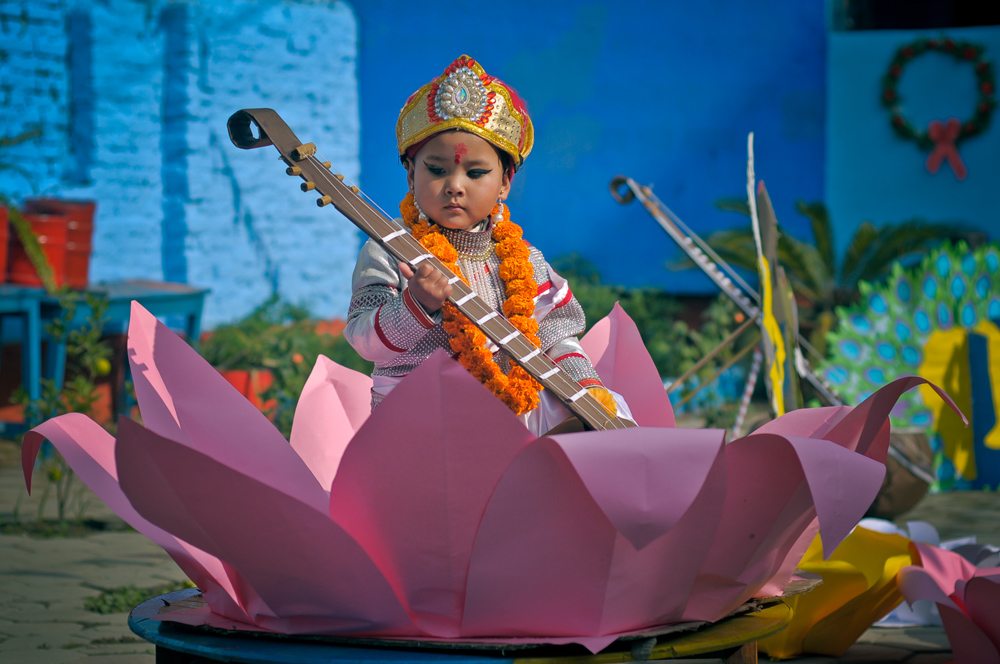Saraswati Puja, also known as Basanta Panchami or Shree Panchami, is celebrated every year in Nepal to honour the Hindu goddess of knowledge, music, and art, Saraswati. The festival typically falls on the full moon day of the month of Magh, which is usually in January or February. Saraswati Puja is an important festival in Nepal and holds great significance in Hindu culture. The festival is particularly important for students, scholars, and anyone who values knowledge and education. The goddess Saraswati is believed to be the embodiment of knowledge and wisdom, and the festival is an opportunity to seek her blessings and guidance. During the festival, people visit temples to offer prayers and make offerings to the goddess. Schools, colleges, and other educational institutions also hold special puja ceremonies to seek blessings for the students and teachers.
The festival is seen as a time to renew one’s commitment to education and self-improvement. Many students worship on the day of the festival in order to honour the goddess of knowledge. This is to remind them to focus on their studies and to strive for knowledge and wisdom in all aspects of life. Saraswati Puja is also an opportunity to celebrate and honor arts and culture. Basanta Panchami is a festival of Hindus that marks the beginning of preparations for the spring season. It is celebrated by people in various ways depending on the region. Basanta Panchami also marks the start of preparation for Holika and Holi, which occur forty days later. For many, Basanta Panchami is the festival dedicated to goddess Saraswati who is their goddess of knowledge, language, music, and all arts. She symbolizes creative energy and power in all its forms, including longing and love. The season and festival also celebrate the agricultural fields' ripening with yellow flowers of mustard crop, which Hindus associate with Saraswati's favourite colour. People dress in yellow saris or shirts or accessories, share yellow-coloured snacks and sweets. Some add saffron to their rice and then eat yellow cooked rice as a part of an elaborate feast.
Gai Puja, Goru Puja and Govardhan Puja today

Many families mark this day by sitting with babies and young children, encouraging their children to write their first words with their fingers, and some study or create music together. The day before Basanta Panchami, Saraswati's temples are filled with food so that she can join the celebrants in the traditional feasting the following morning. In temples and educational institutions, statues of Saraswati are dressed in yellow and worshiped. Many educational institutions arrange special prayers or Pujas in the morning to seek the blessing of the goddess. Poetic and musical gatherings are held in some communities in reverence of Saraswati. As the goddess is also considered to be the patroness of music, art, and literature, so the festival is a time to appreciate these things, seek inspiration and guidance in creative pursuits. Moreover, it is also seen as an opportunity to strengthen the bond between students and teachers, as well as to recognize the contributions of educators to society. Schools and educational institutions hold special puja ceremonies and cultural programs to mark the occasion, and it is a time for students and teachers to come together and celebrate their shared love of learning.
Overall, Saraswati Puja is an important festival that serves as a reminder to value education, knowledge, arts, and culture, and to strive for wisdom and self-improvement in all aspects of life. It is celebrated with great enthusiasm and devotion in Nepal and is an opportunity for people to come together to honour the goddess and seek her blessings for the coming year. It is also a reminder to focus on education and self-improvement and to strive for knowledge and wisdom in all aspects of life. All of us should know the importance of this great festival and celebrate with great enthusiasm.








































